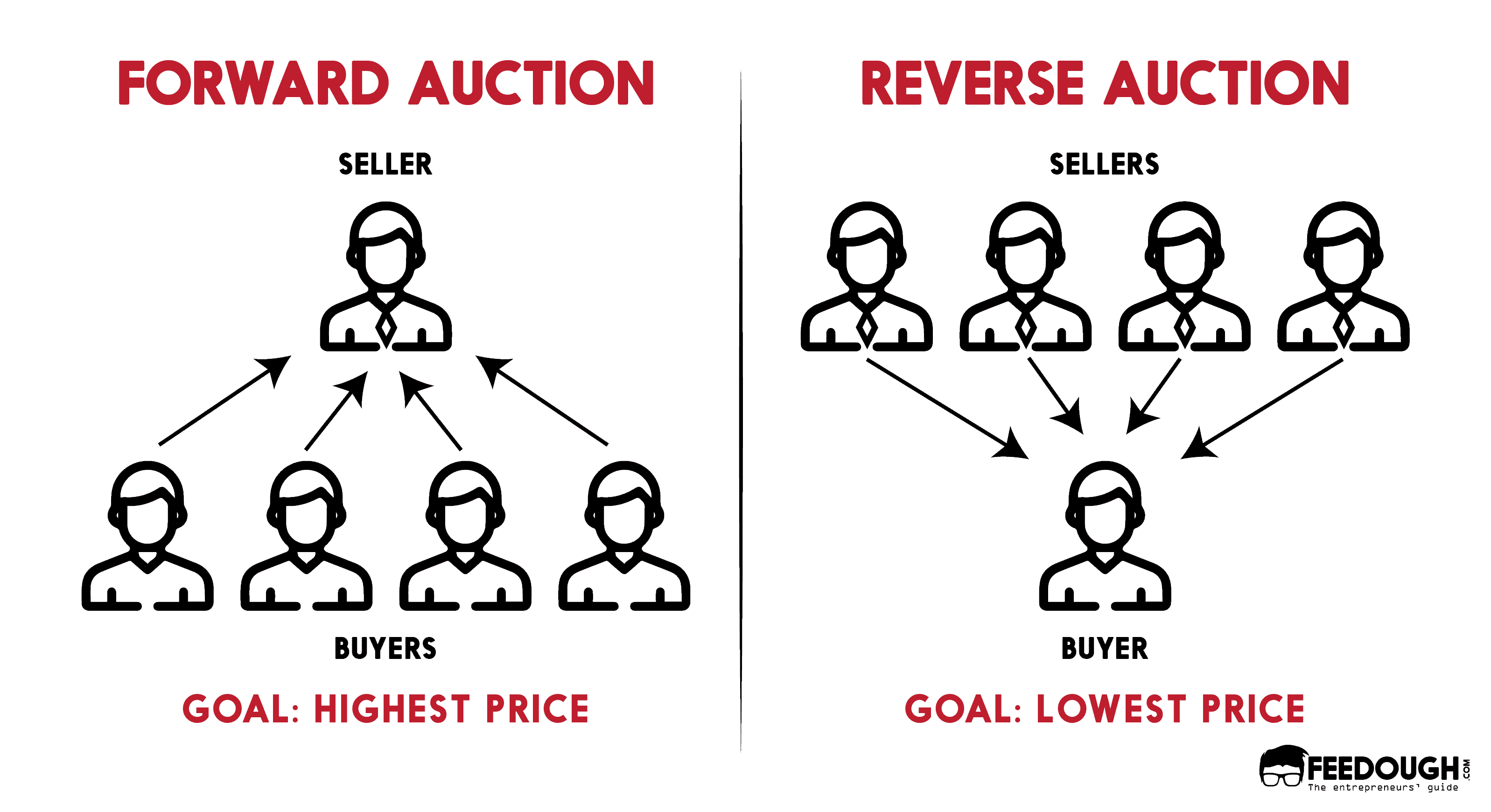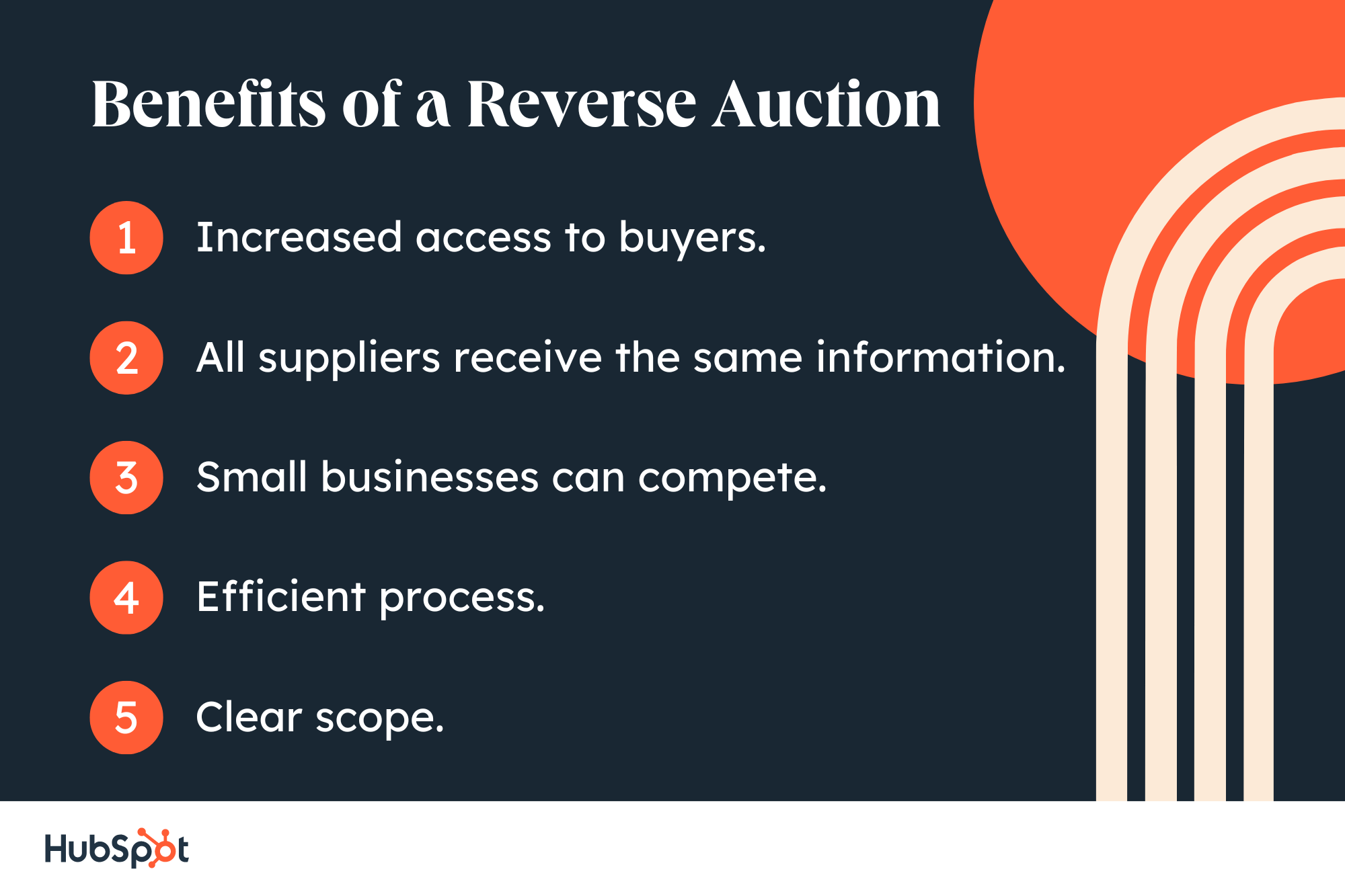Table of Contents
- What is a reverse auction?
- Benefits of a Reverse Auction
- Reverse Auction Examples
- Dutch Auction
- Reverse Auction Best Practices
With many reverse auctions facilitated online and B2B, the process is also referred to as:
- eProcurement.
- B2B auction.
- Procurement auction.
- Sourcing event.
As a seller, you would put your offerings up for bid in a reverse auction, instead of having buyers compete to buy your goods as you would in a traditional auction. For buyers, there are many benefits of conducting a reverse auction, including:
- Competitive pricing. Because sellers compete to win over the buyer, pricing is a major factor in the decision-making process. This can result in the buyer getting a better deal than they would otherwise.
- Expedited procurement process. When sellers bid during a reverse auction, they put the best features of their product or offering in front of the buyer for their consideration. This greatly reduces the time buyers need to spend researching their options, expediting the entire process.
- Ability to meet deadlines. Since auctions often have a set date, many buyers can consider when sellers can provide their offerings in their decision. This means goods are typically delivered on time, and production deadlines are met.

Benefits of a Reverse Auction
As a seller, you may wonder, “What’s in the reverse auction process for me?” There are several benefits to participating in a reverse auction for sellers.

1. Increased access to buyers.
With many reverse auctions now being conducted online, sellers can have the opportunity to bid for work from buyers around the world, which gives you increased access to selling your product beyond your current reach.
2. All suppliers receive the same information.
In a reverse auction, you won’t be left wondering if other sellers know something you don’t know. Because all sellers are responding to the same request for proposal (RFP), everyone receives the same information from the buyer, leveling the playing field in competitive markets.
3. Small businesses can compete.
In some traditional procurement settings, smaller companies have difficulty getting in the door with the contacts needed to make the sale. However, with reverse auctions, no contact or “in” is needed. This even playing field makes reverse auctions more accessible to smaller companies that may not be as well connected.
4. Efficient process.
The reverse auction process moves fast. This can benefit both sellers and buyers as they each save time that would otherwise be spent in the research or selling phases. Sellers can dedicate the saved time and resources to other sales by participating in a reverse auction.
5. Clear scope.
Instead of figuring out what a buyer needs, the buyer outlines what they’re looking for at the start of a reverse auction. This eliminates any confusion or back and forth. Sellers can go into the process with a clear scope of the buyer's needs.
Reverse Auction Examples
It’s important to note that a reverse auction strategy may not be ideal for all industries. However, there are some industries and business scenarios in which the reverse auction model serves particularly well for both the buyer and the seller. Those include:
1. Government Contract Bids
A reverse auction process is most commonly used when government entities contract work to outside suppliers. For example, if NASA needed parts or supplies for satellites, they could run a reverse auction to source bids from potential suppliers.
On the flip side, if you provide IT support to government agencies, your company could respond to a request for proposal from a government agency to submit a bid for the suite of services you provide.
2. Manufacturing
Companies that manufacture their products often use the reverse auction process to source suppliers. For example, if an aerospace company is sourcing suppliers to provide batteries for a new aircraft, companies that make the needed battery could submit a bid to supply the battery for aircraft production.
3. Technology Services
Organizations, such as school districts or companies, that do not have internal technology support can use the reverse auction process to procure technology goods and maintenance services needed for their operations.
While the price is often a factor for buyers during the reverse auction process, buyers tend to base their final decision on the entire package a seller offers to factor in product quality, delivery, and production schedule in their decision.
On the other hand, a Dutch auction places greater emphasis on price. What’s a Dutch auction?
Dutch auctions are often used in an Initial Public Offering (IPO) to determine the appropriate price for a particular stock.
For example, let’s say that during an IPO, an auctioneer is attempting to auction off 1,000 shares of stock and receives no bidders for the initial high price of $100 per share. From there, the auctioneer incrementally lowers the initially high cost per share.
So let’s say the first buyer purchases 50 shares at $60 per share. As the auctioneer continues to lower the price, a second buyer purchases 60 shares at $50 per share, continuing on until all shares have been accounted for.
The auctioneer can continue to lower the price until all shares are purchased. The final cost of all shares will be equivalent to the value bid by the last buyer. So, if the final buyer purchased the last 100 shares for $45 per share, the final value of the stock would be $45 per share.
Participating as a seller in a reverse auction can help companies stay competitive and get on the radar of potential buyers. For more winning B2B sales tips, check out this post.
Reverse Auction Best Practices
If you’re working on creating your reverse auction strategy, you have to know how exactly the process works to stay competitive. To stand out from the competition, keep these best practices in mind.

1. Review the request for proposal (RFP).
A reverse auction must start with either a request for proposal (RFP) or a request for quotation (RFQ). This specifies what goods or services the buyer is looking for, the quantity they need, and the deadlines they are working under.
Before a seller can make a bid, it’s critical to review the RFP carefully. The last thing you want is to have your bid accepted only to realize you can’t make the deadline the buyer initially shared.
2. Know your numbers.
Another best practice for sellers that want to participate in a reverse auction is to know your pricing before you start the bidding process. Once the buyer shares the RFP, sellers need to provide detailed information on what their product is, how much it costs, and verification that they can provide it to the buyer when required.
This means you must know these numbers ahead of time to confidently share that information with accuracy and efficiency. While you can modify your offerings throughout the bidding process to remain competitive, it’s key to know your limits.
3. Stay competitive.
If you’re a smaller company trying to get your foot in the door of a certain industry or work with government customers, then participating in a reverse auction helps get you on their radar. But to stay in the running, you must stay competitive.
Price is the main factor buyers will consider when comparing bids, so position yourself competitively in the market. Buyers will also consider the quality, delivery, and production process of each bid, so consider all elements of your offering to figure out how you can stand out among the other bidders.
4. Establish a minimum price.
Related to the point about knowing your numbers, sellers must know when to walk away. In a reverse auction, sellers will lower their prices to remain competitive against other bidders. It can be tempting to continue bidding (and, as a result, lower your price) to win the contract, but you have to establish the minimum you’re willing to bid.
At a certain price point, the contract may end up not being worth it. Establish your bottom line and stay firm when the bidding gets to that point.
Once the bidding process closes, the buyer goes through all of the information submitted by the sellers and can deliberate to make their final decision. Once they notify the winning bidder, the two parties can work together to determine the terms of their agreement to have the work fulfilled.
Getting Started
Understanding the benefits and best practices of a reverse auction prepares your sales team for success if you find yourself in this type of selling scenario. So decide your minimum bids and research your competitors. Then, it’s time to secure business!
Competitive Sales

.jpg)
